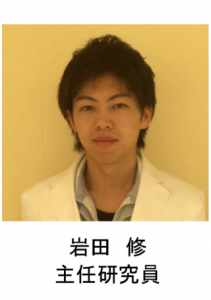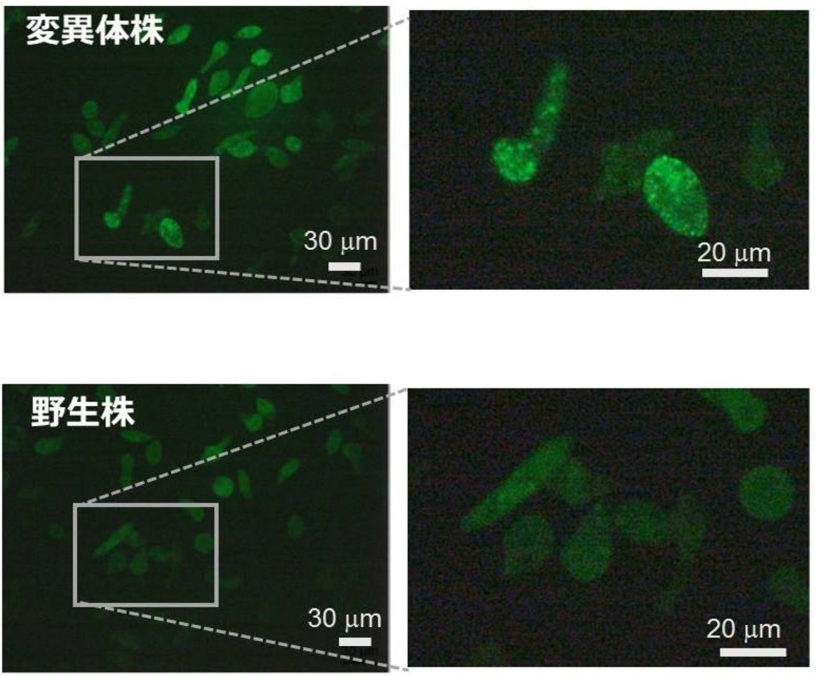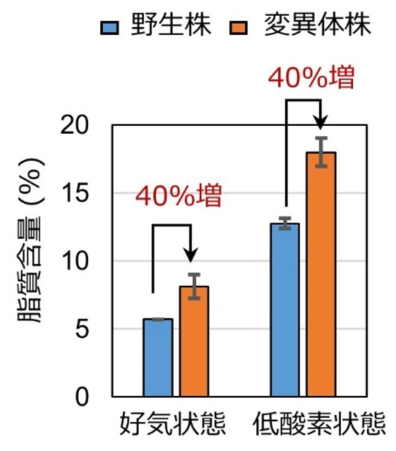ニュースリリース
※ ニュースリリースは発表当時の内容を掲載しており、最新の情報とは異なる場合がありますためご注意ください。
油を多く産生するユーグレナ変異体を選抜する品種改良法の開発に成功
株式会社ユーグレナ
東京大学
国立研究開発法人理化学研究所
国立研究開発法人科学技術振興機構
内閣府政策統括官(科学技術・イノベーション担当)
~ポイント~
○ 個々のユーグレナの油脂含有量を観測する方法を確立した。
○ 油脂含有量の多いユーグレナ変異体を選抜取得することに成功した。
○ ユーグレナの産生する油脂を利用したバイオ燃料研究への展開が期待される。
内閣府 総合科学技術・イノベーション会議が主導する革新的研究開発推進プログラム(ImPACT)の合田圭介プログラム・マネージャーの研究開発プログラムの一環として、株式会社ユーグレナの岩田修主任研究員(ImPACTチームリーダー)、東京大学 大学院理学系研究科の合田圭介教授らは、ミドリムシ(学名:ユーグレナ)変異体を効率的に作出し、選抜する品種改良法(注1)を開発しました。
ユーグレナは、食品やバイオ燃料への応用が進められています。これまでよりも栄養価の高いユーグレナや燃料生産効率の高いユーグレナの発見も期待されていますが、個体ごとにわずかに特徴の異なる膨大な数のユーグレナから、目的の特徴を持つユーグレナを選抜することは困難であり、効率的な手法の開発が求められていました。
本研究グループは、細胞選別技術を用いてユーグレナを効率的に選抜する手法を開発しました。また、その手法を用いて、理化学研究所仁科加速器研究センターにおいて重イオンビーム(注2)を照射して作出した様々な特徴を持つユーグレナの集団の中から、これまでよりも油脂を多く含むユーグレナの取得に成功しました。
この選抜技術を現在開発中のセレンディピター(注3)と組み合わせることで、さらに膨大な数のユーグレナから有用な特徴を持つものを取得することが可能になると考えられます。これにより、ユーグレナによる高効率バイオ燃料の研究などを加速させることに役立つことが期待されます。
本研究成果は、2016年5月23日10時(英国時間)にネイチャー・パブリッシング・グループ(NPG)の電子ジャーナル「Scientific Reports」で公開されます。
本成果は、以下のプログラム・研究開発課題によって得られました。
 内閣府 革新的研究開発推進プログラム(ImPACT)
内閣府 革新的研究開発推進プログラム(ImPACT)
http://www.jst.go.jp/impact/
プログラム・マネージャー:合田圭介
研究開発プログラム:セレンディピティの計画的創出による新価値創造
研究開発課題:遺伝的に多様な細胞集団の取得方法の確立
研究開発責任者:鈴木健吾(株式会社ユーグレナ 研究開発部)
チームリーダー:岩田修(株式会社ユーグレナ 研究開発部)
研究期間:2014年11月~2017年3月
本研究開発課題では、単一細胞の分解能で高速・正確に細胞を刺激する基盤技術の開発に取り組んでいます。その中で、岩田チームは、分取する価値のある細胞が含まれた遺伝的に多様な細胞集団をセレンディピターで創出する「遺伝的に多様な細胞集団の取得方法」の開発に取り組んでいます。
 ■合田圭介プログラム・マネージャーのコメント■
■合田圭介プログラム・マネージャーのコメント■
本成果は、内閣府革新的研究開発推進プログラム(ImPACT)「セレンディピティの計画的創出による新価値創造」に参画する株式会社ユーグレナの研究チームによるものです。本チームでは、膨大な数の細胞集団に様々な刺激を与え、分取すべき有用な細胞自体の創出およびそれを見分けるための技術を開発しています。産業利用を想定したユーグレナの品種改良については、これまでほとんど報告されておりませんでしたが、今回の成果は実際に高油脂生産ユーグレナの品種改良が可能であり、本プログラムにおいて開発する各技術が実現することで、より有用なユーグレナを取得できる可能性を示しています。今後、油脂を超高生産するスーパーユーグレナを見つけられるようにプログラムを推進していきます。
<発表内容>
1)研究の背景と経緯
微細藻類や酵母等の微生物は、変異原処理(注4)をすることで野生株とは違う様々な特徴をもつ細胞を出現させることが可能であり、その中から有用な特徴をもつものを選抜する技術があれば、産業的な応用につながる株の取得(品種改良)が可能です。今回研究対象としたユーグレナは「ミドリムシ」として知られる生物の学名であり、主に世界中の淡水域に生息する微細藻類の一種です(図1)。しかし、他のよく研究されている微細藻類(例えばクラミドモナス)と比較して、効率的な変異原処理、および個体選抜技術が確立されていないため、目的の特徴をもつユーグレナの取得が困難でした。また、このことから、希望の形質を示す変異体を獲得できるかも十分に検証されていませんでした。ユーグレナはすでに食品素材として産業的に応用がなされていますが、イネやトウモロコシなどの植物と同様に効率的に品種改良することが可能となれば、より幅広い活用が期待できます。
2)研究の内容
株式会社ユーグレナ、東京大学、理化学研究所から構成された研究グループは、細胞刺激(変異原処理および蛍光染色)を組み合わせることで、遺伝的に多様なユーグレナの集団を作出し、そこから効率的に今回目的とした油脂含有量を多く含むユーグレナの選抜に成功しました。
変異原処理として重イオンビーム照射を細胞に行うと、様々な特徴をもった細胞が集団の中に現れます。本研究では、これをユーグレナに照射して様々な特徴をもったユーグレナが含まれる集団を作りだし、それと併せて、セルソーター(注5)を利用することによりユーグレナの個々の細胞を観測し選抜する方法を開発しました(図2)。特に、種々の条件検討から、選抜時にユーグレナがダメージを受けにくい条件を見出したことは選抜をする上で有効であったと考えられます。そのうえで、BODIPY染色(注6)により細胞内の油脂を可視化し、蛍光強度の違いを利用して、作り出した多様な細胞集団の中から特に油脂を多く含むユーグレナを選抜できるか検証を行いました。その結果、野生株より約40%油脂を多く含むユーグレナ変異体を取得することに成功しました(図3、図4)。本ユーグレナ変異体は油脂を多く産生することから、ミドリムシバイオ燃料の原料として優秀であり、生産性の向上に寄与することが期待されます。また、以上の結果から、本研究で検証した方法を利用することで目的のユーグレナを選抜できることが実証されました。
3)今後の展開
今回ユーグレナを選抜するにあたっては既存のセルソーターを利用しました。将来的には、そのプロセスを本ImPACTプログラムで開発中のセレンディピターを用いて行うことを想定しています。セレンディピターにより、より多くの質の高い情報をユーグレナから取得して選抜に用いることで、さらに油脂を大量に含んだユーグレナをより高速かつ的確に選抜できる可能性があります。また、可視化方法を工夫することで、油脂含有量以外にもビタミン含有量の多いユーグレナなどの産業的に有用な特徴をもつユーグレナを選抜することが可能になると考えられます。さらに、ユーグレナ以外の微細藻類にもセレンディピターの応用を検討することで、機能性成分やバイオ燃料の研究の加速が期待されます。
本発表におけるユーグレナ育種の技術開発、および実証はImPACTプログラム(合田プログラム・マネージャー)における株式会社ユーグレナの岩田修主任研究員のチームによる成果であり、重イオンビーム照射による品種改良技術は内閣府戦略的イノベーション創造プログラム(SIP)の一環として理化学研究所仁科加速器研究センターで開発しています。
<参考図>

図1. ユーグレナに蓄積した油脂の可視化

図2. 多様なユーグレナを含む集団の作出と変異体の選抜

図3. BODIPY染色した元のユーグレナ(野生株)と変異体ユーグレナの顕微鏡画像
蛍光が強い細胞ほど油脂を多く含む。

図4. 油脂含有量の比較
<用語解説>
※1 作出、選抜、品種改良…ユーグレナの遺伝情報が含まれるDNAにランダムに変異を導入することにより、様々な特徴を持った変異体を含む集団を作出します。その集団中の各個体の特徴を評価した上で、目的に合致した個体をセルソーターで選抜し、品種改良を行います。
※2重イオンビーム照射…原子からいくつかの電子がはぎ取られて、電気を帯びたものが「イオン」と呼ばれ、特にヘリウムより重い元素のイオンは「重イオン」と呼ばれます。DNA二重鎖を切断し塩基欠失を誘発できることから、植物等の効率的品種改良にも用いられています。本研究では、理化学研究所仁科加速器研究センターにおいて加速された高エネルギーを持つ鉄イオンを照射し、ユーグレナゲノムに変異を誘発しています。
※3 セレンディピター…膨大な数(1兆個以上)の細胞集団から、希少だが大きなインパクトをもつ細胞を、迅速・正確かつ低コスト・低侵襲に発見し徹底的に解析する装置です。
※4 変異原処理…変異原(紫外線や化学変異原等)に生物を曝露することにより、遺伝子変異を誘発させ、変異体を出現させる処理です。
※5 セルソーター…細胞の発する蛍光強度等を指標として流路内の細胞を観測し、目的の細胞を分取する装置です。
※6 BODIPY染色…蛍光色素BODIPYを使い細胞内の脂質を染める染色方法です。BODIPYは細胞毒性が無いことも特徴です。
<発表雑誌>
雑誌名: Scientific Reports
論文タイトル:Efficient selective breeding of live oil-rich Euglena gracilis with fluorescence-activated cell
sorting
(FACSを利用した高油脂含有ユーグレナの効率的育種)
著者: Koji Yamada, Hideyuki Suzuki, Takuto Takeuchi, Yusuke Kazama, Sharbanee Mitra,Tomoko Abe,
Keisuke Goda, Kengo Suzuki, Osamu Iwata
―報道関係者お問い合わせ先―
株式会社ユーグレナ 広報IR課
